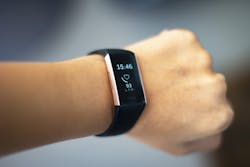SLC 2022 Preview: What You Need to Know About Wearables
Maybe you wear a fitness monitor or a smart app. Maybe you don’t. Either way, you’re already generating huge amounts of information and data through your daily life.
Wearables aren’t new, but how they’re used and what they’re used for continues to evolve. One area where wearables are piquing more interest is in workplace safety, and they’re being used for everything from tracking repetitive movements to measuring biometrics to monitoring air quality. There’s a whole host of use cases that are just starting to be explored, with many more on the way.
EHS Today spoke with Tom West, vice president of marketing at MākuSafe, and Mark Jones, EHS director of Plastipak Packaging, about the realm of possibilities—and potential concerns—about considerations for wearable safety tech and how to calculate a return on investment (ROI) of safety technology purchases.
West and Jones will speak at the 2022 Safety Leadership Conference, being held in Cleveland from Oct. 18-20. Below is a preview of what to look forward to this fall.
EHS Today: What's the biggest misconception you hear about wearables?
One is talking with leaders who are set on the idea that they want something to “buzz the worker in order to get them to change their behavior [because] that’ll get us where we want to go in our safety program.”
Early on, we realized worker behavior may not be the problem that needs to be targeted. Furthermore, workers may not even know what to do to correct a problem. Certainly, anyone who is wearing something that is constantly buzzing isn’t going to be happy about it, and it may even cause a distraction or hazard.
Occasionally, an end user organization says, “This is new and sounds neat. We'd like to give wearables a try. We'll make it voluntary for a small handful of our workers.” After working in this space for many years, we know this doesn't generally work out very well. Organizations really need to know what they are trying to achieve, how to measure impact and commit to a fair evaluation of how hazard and risk insights can provide value to their safety and, ultimately, business objectives.
How can safety professionals translate the massive amounts of data wearables generate into safety improvements? TW: They shouldn't have to! If safety managers have an appetite for these actionable insights, a willingness to proactively go out and do an observation, or have a 3-minute conversation with the front lines to understand what’s happening, then they should easily reap the benefits of data evidence. This enables better decision-making about mitigating risks and implementing hazard controls and justifies taking corrective actions to keep workers safe.
Has COVID-19 affected perspectives about or the adoption of wearables?
TW: This seems to have been a double-edged sword. I believe the pandemic made many more willing to look for innovative solutions or technology that could help them with the gigantic responsibilities they found themselves being asked to shoulder. However, most organizations were stretched so thin with new critical objectives, initiatives and the tasks associated with carrying all this out that many just didn't have the capacity to implement a new pilot or trial and then manage it.
What have been your greatest challenges or concerns in considering the use and implementation of wearable technology?
What's something unexpected you've seen or learned as a manufacturer of wearables?
TW: We routinely see hidden things that safety leaders hadn't considered or thought shouldn't be a concern—pockets of poor air quality, for example—or workers achieving their [total weight average] TWA of sound dosage within the first couple of hours of their shift. Examples of a high degree of repetitive movement or physicality required by one worker even though many others perform the same tasks in their role. These insights allow them optics into the unknown, and they can take action to mitigate those risks before an incident occurs.
One of my favorite examples recently was we noticed indicators of strain and exertion from one worker in particular that caused our safety leader customer to want to find out why. This was not a line worker but someone who provided support. The aging worker, when asked, was easily able to point out "I know what you're seeing! I pull this heavy cart around every day, and I haven't had time to tell anyone yet that one of the casters is broken." We didn't design a device to detect broken wheels on a cart, so it was surprising that we were able to gather data that could be used to keep that worker from straining.
What's one thing you hope attendees learn from your session at the Safety Leadership Conference?
TW: Well, a few takeaways, for sure.
How wearable tech can provide a unique means of gathering EHS leading indicators of potential hazards and risks [while,] at the same time, protecting against worker privacy concerns.
How deploying wearable safety technology can be economical and effective and contribute to sending people home safely every day. We'll share use case examples from a variety of industries.
About the Author
Nicole Stempak
Nicole Stempak is managing editor of EHS Today and conference content manager of the Safety Leadership Conference.



